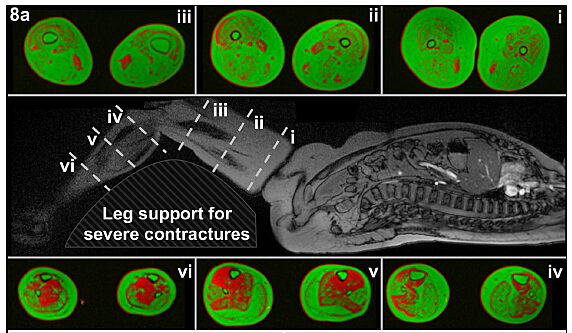New $6.25 million grant allows UF to expand 10-year study of muscular dystrophy disease progression

A new five-year, $6.25 million grant from the National Institutes of Health will support the University of Florida’s continued efforts to develop MRI biomarkers for individuals with Duchenne muscular dystrophy, and expand the study to include people with Becker muscular dystrophy.
Duchenne muscular dystrophy, or DMD, is a severe form of the disease that affects about one in 3,500 males born each year in the United States. It occurs when there is a change in DNA that prevents the body from producing dystrophin, a protein that is needed to keep muscles healthy. Without this protein, muscles become weaker over time, lose the ability to regenerate and become replaced by fat and connective tissue.
Most people with DMD lose the ability to walk in early adolescence and may spend more than half of their life as a wheelchair user. Yet, this population is excluded from most treatment clinical trials due to a lack of clinically relevant outcome measures.
In 2010, Krista Vandenborne, Ph.D., a distinguished professor and chair of the department of physical therapy in the UF College of Public Health and Health Professions, and colleagues received a $7.5 million NIH grant to develop a multicenter study known as ImagingDMD. This grant enabled the researchers to work with young boys with DMD to develop sensitive MRI biomarkers that could detect muscle damage and inflammation in dystrophic muscles, even in the early stages of the disease. Five years later, Vandenborne was awarded an additional $7.15 million NIH grant to continue to follow DMD progression in the 136 boys who participated in the first imaging project.
The MRI measures developed as a result of these studies are now used in many clinical trials in ambulatory boys with DMD. The MRI biomarkers have allowed for faster determinations of whether investigational drugs are effective, potentially providing patients access to therapeutic drugs years earlier.
For the new five-year study, Vandenborne and her team plan to develop new MRI biomarkers that are sensitive across a wide range of ages and mobility stages, including in individuals who can no longer walk. Additionally, since the disease also affects the ability to breathe, UF researchers will test MRI measures of respiratory muscle health that can be used in clinical trials targeting participants in more advanced disease stages.
“We are honored that the NIH values the ImagingDMD study, as evidenced by the 15 years of funding, and look forward to continuing to work with the boys and families to help find a cure for this devastating disease,” Vandenborne said. “Expansion of the ImagingDMD study will greatly benefit the DMD community as a whole, as ImagingDMD natural history data are shared with academic colleagues and industry partners across the country to help design new trials and pursue novel therapeutic strategies.”
Furthermore, the UF research team will initiate a comprehensive MRI biomarker study in adults with Becker muscular dystrophy, or BMD, a population that has largely been omitted in therapeutic development.
BMD is similar to DMD, but because a small amount of dystrophin is present in the muscles, the symptoms are milder and progress more slowly than in DMD.
In this new arm of the program, Vandenborne and her team will develop whole-body MRI biomarkers and examine the critical relationship between dystrophin protein production, MRI measures of disease progression and the DNA variants causing BMD.
The researchers hope this work will pave the way for trials in small populations of adults with BMD, and will be instrumental in informing upcoming gene therapy clinical trials targeting restoration of dystrophin protein in DMD.
“This study is expected to have an immediate impact on clinical trials in DMD by expanding the inclusion criteria to include non-ambulatory patients and providing the tools needed to test drugs for advanced disease stages,” Vandenborne said. “With access to an extensive imaging clinical trial network across the U.S. and Europe, we are poised to rapidly employ these new MRI biomarkers to support clinical trials in small populations of BMD patients and test promising gene therapy and other therapeutic candidates in DMD. Lastly, this work will likely inform and advance therapy development in other neuromuscular diseases.”
Media contact: Ken Garcia at kdgarcia@ufl.edu or 352-273-9799.